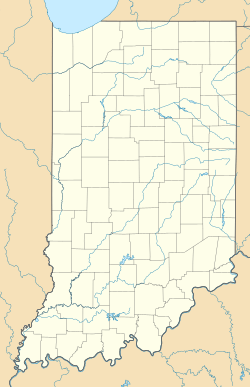Mann Site facts for kids

Overview of the site, looking west
|
|
| Location | Mt. Vernon, Indiana, Posey County, Indiana, |
|---|---|
| Region | Posey County, Indiana |
| Coordinates | 37°54′44.5″N 87°50′20″W / 37.912361°N 87.83889°W |
| History | |
| Cultures | Crab Orchard culture |
| Site notes | |
| Architecture | |
| Architectural details | Number of temples: |
|
Mann Site
|
|
| Area | 300 acres (120 ha) |
| NRHP reference No. | 74000018 |
| Added to NRHP | October 01, 1974 |
| Responsible body: Private | |
The Mann Site (also known as 12 Po 2) is an important ancient place in Mount Vernon, Posey County, Indiana. It was home to people of the Crab Orchard culture. This site was added to the National Historic Register on October 1, 1974, showing its historical value.
Archaeologists have found special pottery and other items here. These finds show that the people at the Mann Site traded and connected with other groups. These groups included the Ohio Hopewell people and the Swift Creek culture people from places like Georgia.
Contents
Discovering the Mann Site
The Mann Site is a very large and old complex of mounds and earthworks. It also has areas where people used to live. This site dates back to the late Middle Woodland period, roughly between 100 and 500 CE. It is located in southwestern Indiana, where the Wabash and Ohio Rivers meet.
What Makes the Site Special?
The site sits on a high piece of land next to a river, called a river terrace. The size and complexity of the mounds and earthworks at the Mann Site are very impressive. In the entire Midwest, only the Hopewell sites in southern Ohio are similar in scale. The Mann Site might have even had more people living there than some of the famous Ohio Hopewell centers.
Uncovering Ancient Connections
Many unique items found at the Mann Site show that its people were part of a larger network. They took part in special ceremonies and had a social system where some people had higher status. These items were often made from materials not found locally.
Pottery and Trade Routes
One interesting discovery is the large amount of special pottery. This pottery has unique designs, like complicated stamped, simple stamped, and tetrapodal (four-footed) shapes. While common in the southeastern United States, these types of pots are rare in the Ohio Valley.
These ceramics look very similar to early Swift Creek culture pottery. This pottery is usually found in the Georgia Piedmont and Gulf Coastal Plain regions. Some designs at the Mann Site are exactly like those found in Georgia.
Evidence of Distant Trade
Scientists used special tests, like x-ray diffraction analysis, on these artifacts. They found that the pottery likely came from the Blue Ridge and southern Appalachian Piedmont Provinces. This suggests that people from the Mann Site had connections with groups far away.
For example, sites in the Blue Ridge and southern Appalachian Piedmont Provinces, from a time called the Connestee phase (around 200 to 500 CE), were in contact with Ohio Hopewell groups. This is known because their pottery shared similar shapes, decorations, and materials.
Unique Local Creations
The rare pottery at the Mann Site suggests that direct contact between Ohio Hopewell people and groups in the Appalachian Summit area, Georgia Piedmont, and Gulf Coastal Plain was not common. It seems that pottery sometimes traveled north.
However, another interesting thing is that people at the Mann Site also made their own pottery using Georgian Piedmont designs. This shows they were not just receiving goods, but also adopting and creating their own versions of these styles. Similar diamond-checked pottery designs have been found at other Hopewell sites in Ohio and southeastern sites like Leake Mounds in Georgia and the Yearwood site in Tennessee.



